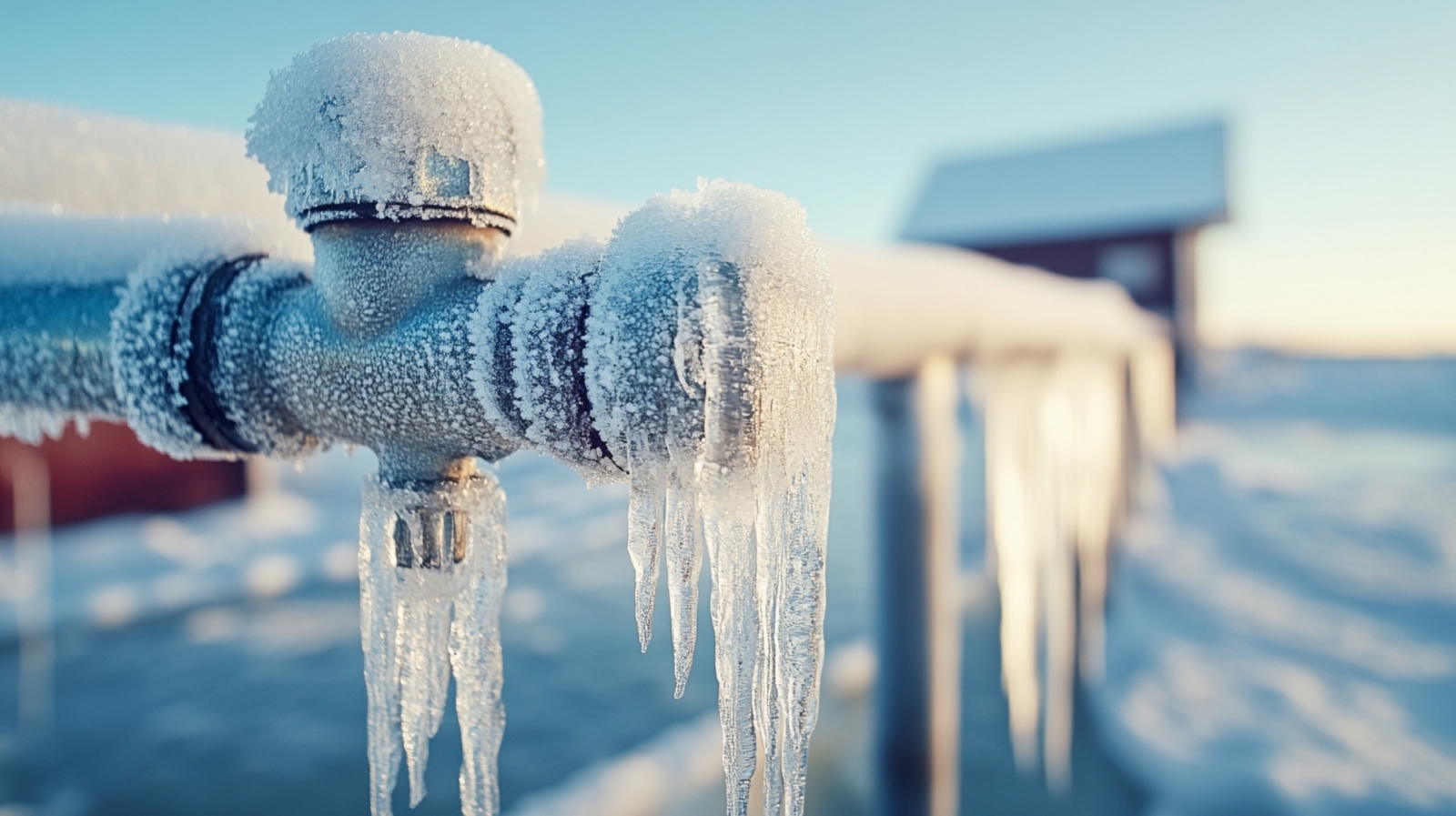What Is the Difference Between a Frozen Pipe and a Burst Pipe?

As we get into winter, we start to see temperatures drop. With inclement weather, one of the biggest concerns for homeowners and business owners alike is the condition of their plumbing system.
Frozen and burst pipes are common issues that can cause significant damage and disruption to your life, your business and your wallet. But what exactly is the difference between a frozen pipe and a burst pipe, and why do these problems occur? Let’s get into understanding these distinctions, preventing costly repairs and safeguarding your property during cold weather. We are here to help you prepare, plan and prevent!
Understanding Frozen Pipes
A frozen pipe occurs when the water inside a pipe freezes due to low temperatures. Water expands as it turns to ice, and this expansion creates an immense pressure inside the pipe. Something to keep in mind, frozen pipes are more common in unheated or poorly insulated areas of a building, such as basements, crawl spaces, attics, garages, or exterior walls.
So, what are the signs of a frozen pipe? If you know the signs, it’s much easier to prevent frozen pipes from happening in the first place! Here are some of the most common things to monitor.
No Water Flow: A frozen pipe can block the flow of water, causing little to no water to come out of your faucets.
Frost on the Pipe: Visible frost or ice buildup on the outside of the pipe is a telltale sign.
Unusual Odors: A partially frozen pipe can trap odors, causing them to back up into sinks or drains and potentially leading to conditions that require mold remediation.
Bulging Pipes: In severe cases, pipes may bulge due to the internal pressure from expanding ice.
Frozen pipes can often be thawed before causing further damage, if detected early. However, if left unaddressed, a frozen pipe can lead to a burst pipe.
What Happens During a Burst Pipe?
A burst pipe is the result of excessive pressure inside a pipe that exceeds the pipe’s structural integrity. This pressure can be caused by the expansion of frozen water or by blockages and water pressure buildup elsewhere in the plumbing system. A burst pipe is significantly more damaging than a frozen pipe because it can release gallons of water into your home or business in a matter of minutes.
Why Do Frozen Pipes Burst?
The primary reason frozen pipes burst is the ice’s expansion as it freezes. However, it’s not the ice itself that directly causes the burst. Instead, the blockage created by ice buildup increases water pressure in other parts of the pipe, which eventually causes it to rupture at its weakest, most vulnerable point. Below is a breakdown of how frozen piles and burst pipes differ.
Preventing Frozen and Burst Pipes
Taking proactive steps to protect your pipes during cold weather can save you time, money, and stress. Here’s how to prevent frozen and burst pipes:
Insulate Your Pipes: Use pipe insulation or heat tape on pipes in unheated areas and focus on areas like basements, attics, and crawl spaces.
Maintain a Consistent Indoor Temperature: Keep your thermostat at a minimum of 55°F (13°C), even if you’re away. Additionally, open cabinet doors under sinks to allow warm air to circulate around pipes.
Let Faucets Drip: Allow faucets to drip slightly to prevent water pressure buildup and keep water moving through your pipes.
Seal Drafts: Check for drafts around windows, doors, and exterior walls near pipes. Use caulking or weatherstripping to seal gaps.
Disconnect Outdoor Hoses: Remove and store outdoor hoses, and shut off water to exterior faucets if possible.
Locate Your Main Water Shutoff Valve: Knowing how to quickly shut off your water supply can minimize damage in case of a burst pipe.
What to Do If You Have a Frozen Pipe
If you suspect a frozen pipes, act quickly to minimize damage and restore water flow:
Turn Off the Water Supply: Shut off the water to the affected pipe to prevent pressure buildup.
Thaw the Pipe Safely: Use a hairdryer or heat lamp to gently warm the pipe, starting at the faucet and moving toward the frozen section. And, avoid open flames or high-heat devices, as these can damage the pipe or cause a fire.
Check for Leaks: Once the pipe is thawed, turn the water back on gradually and monitor for any leaks or cracks.
Call a Professional: If you’re unable to locate or safely thaw the frozen pipe, contact a licensed plumber.
Responding to a Burst Pipe
A burst pipe requires immediate attention to mitigate water damage and restore your plumbing system. Here's what you can do to minimize the damage:
Turn Off the Water Supply: Shut off your main water valve as soon as you notice a burst pipe.
Drain the System: Open faucets to drain any remaining water and reduce pressure in the pipes.
Address the Damage: Use towels, buckets, or a wet/dry vacuum to remove standing water. Move furniture, electronics, and valuables away from the affected area.
Call a Professional: A licensed plumber can repair or replace the damaged pipe and assess your plumbing system for further risks.
Repair Water Damage: If significant flooding occurs, you may need to hire a water damage restoration company to prevent mold growth and structural issues.
ALL-CLEAN USA – Your Trusted Experts, Available 24/7, Year-Round
Some pipe issues can be handled with basic tools and know-how, but others require expert intervention. Contact a professional plumber or residential restoration company if:
You’re unable to locate or access the frozen pipe.
A burst pipe causes significant water damage.
Multiple pipes freeze, indicating a larger system issue.
Understanding the difference between frozen and burst pipes is crucial for protecting your home or business during winter. While frozen pipes can often be managed if detected early, burst pipes pose a much greater threat to your property. Prevention is always the best approach—insulate pipes, maintain consistent temperatures, and seal drafts to avoid these issues altogether.
Our certified property restoration professionals are here to provide swift, dependable service whenever you need it. Contact us for immediate assistance!


